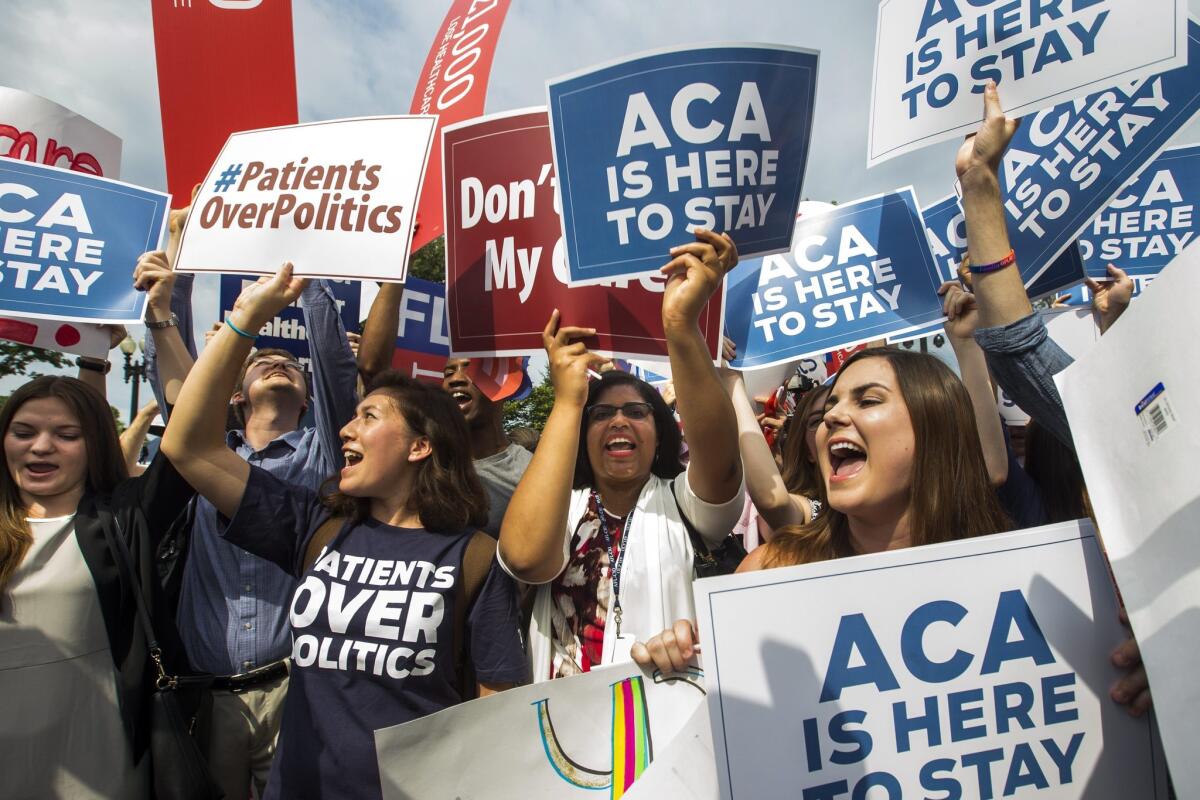Editorial: Obamacare’s ‘Cadillac tax’ could use a tuneup

Supporters of the Affordable Care Act cheer after the Supreme Court ruled that Obamacare tax credits can go to residents of any state, in Washington, D.C. on June 25.
- Share via
The Affordable Care Act slapped a hefty tax on expensive employer-sponsored health plans in an effort to discourage companies from offering the most expansive forms of coverage while also raising money for new insurance subsidies. But the “Cadillac tax” is proving to be an idea that only an economist could love, as critics from the left and the right, from unions and corporate America, have stepped up to denounce it. In fact, Hillary Rodham Clinton and Republicans on the House Ways and Means Committee called for its repeal almost simultaneously last month. Yet the tax, which is slated to go into effect in 2018, may simply take the wrong approach to doing the right thing.
One of the fundamental problems with the healthcare system here is that it consumes too much of the U.S. economy — about 17% in 2012, compared with an average of 9% in other developed nations — and the situation is getting steadily worse. Of the many factors involved, one of the main ones is that insurance shields consumers from much of the cost of their care. That’s a good thing in the sense that people who are covered can afford to get the care they need, but it also increases the incentive for patients to seek (and for doctors to provide) care that’s not essential, while diminishing the incentive to stay healthy.
When companies provide coverage at little or no out-of-pocket cost, that gives employees an even stronger incentive to overuse the healthcare system. To try to curb such benefits, the ACA levies a new tax on plans whose cost exceeds $10,200 for an individual or $27,500 for a family — far higher than the typical comprehensive policy.
That’s a fine idea in theory; requiring employees to pay at least a portion of their healthcare bills will help them become more cost-conscious consumers. But the way Congress designed the tax, it will fall on the plans that cost the most, not necessarily the ones with minimal co-pays and deductibles. And because insurance premiums are likely to rise faster than the tax’s threshold, the levy is expected to hit a growing number of not-so-generous insurance plans — especially in high-cost areas — and employers whose plans are expensive just because their workers rack up large medical bills.
Nevertheless, Congress shouldn’t simply give up on the Cadillac tax. Instead, it should change the trigger so that the tax falls just on plans that impose negligible out-of-pocket costs, rather than plans worth more than a specific dollar figure. That won’t bring in as much revenue for Obamacare as the original Cadillac tax, but that shouldn’t be the main goal. Instead, the point is to remove one of the perverse incentives in healthcare that’s making it hard to hold down costs. That’s an objective both sides of the political aisle should support.
Follow the Opinion section on Twitter @latimesopinion and Facebook
More to Read
A cure for the common opinion
Get thought-provoking perspectives with our weekly newsletter.
You may occasionally receive promotional content from the Los Angeles Times.









